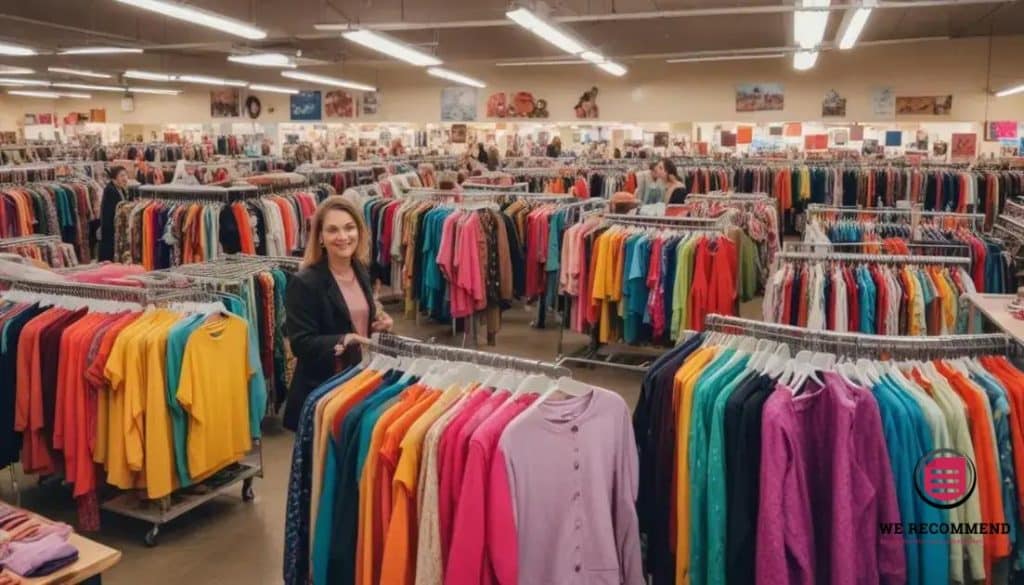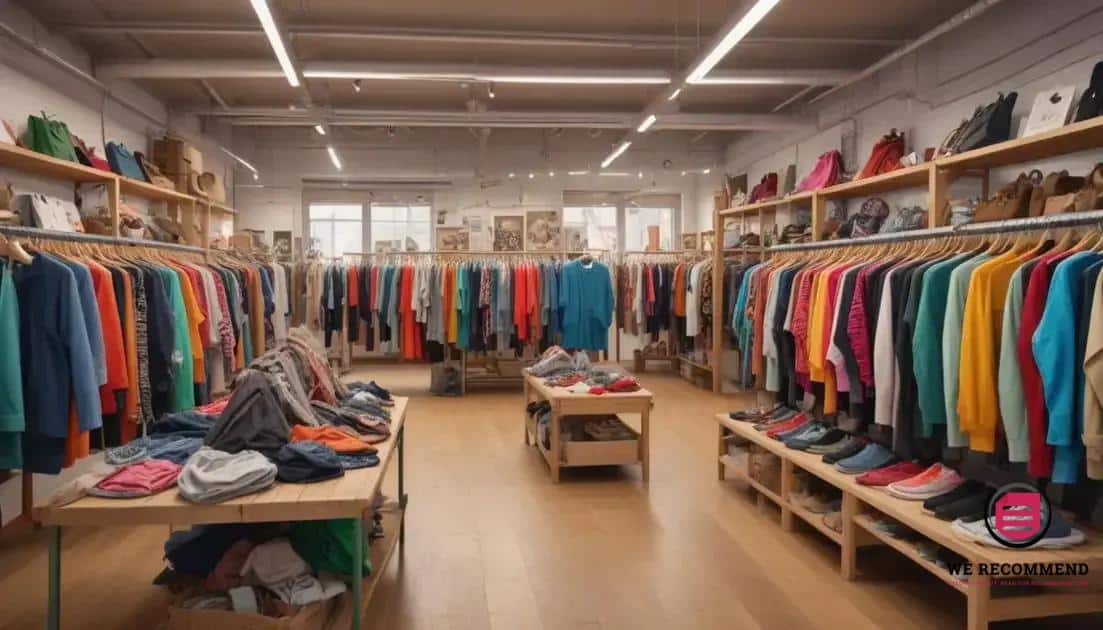Secondhand fashion boom: why it’s reshaping our wardrobes

Anúncios
The secondhand fashion boom is reshaping shopping habits by promoting sustainable choices, offering unique styles, and providing budget-friendly options, making it an essential trend in today’s eco-conscious market.
The secondhand fashion boom is not just a trend; it’s a movement redefining how we shop. Have you noticed more people flaunting unique styles that tell a story? Let’s dive into what’s driving this shift!
Anúncios
Understanding the secondhand fashion boom
The secondhand fashion boom is transforming how we view clothing. More than just a way to save money, it promotes sustainability and individuality.
People are increasingly turning to thrift stores and online marketplaces to find unique pieces that tell a story. This shift has led to a decrease in fast fashion consumption, contributing to a healthier planet.
Anúncios
Why Secondhand Fashion Is Gaining Popularity
Factors driving this trend include:
- Environmental concerns: Many consumers are seeking to reduce waste and their carbon footprint.
- Unique styles: Thrifted items often come with a history, allowing for a more personal expression of style.
- Budget-friendly: Buying secondhand can save shoppers a lot of money compared to purchasing new items.
For more insights into this trend, visit Good On You, a reputable resource on sustainable fashion.
Top benefits of choosing secondhand clothing
Choosing secondhand clothing comes with a host of benefits that appeal to many shoppers today. Not only does it support eco-friendly practices, but it also offers financial savings and unique fashion finds.
One major advantage is the positive impact on the environment. By opting for previously loved clothes, we help reduce the demand for new clothing production, which often leads to significant waste and pollution.
Moreover, secondhand shopping can be very economical. You can get high-quality brands for a fraction of the price. Saving money while being stylish is a win-win!
Key Benefits of Secondhand Clothing
- Eco-friendly: Helps reduce waste and the environmental impact of fashion.
- Unique styles: Each piece has its own history, making your wardrobe distinctive.
- Cost-effective: Get designer or high-quality items at lower prices.
For an in-depth look at the environmental benefits of secondhand shopping, check out Earth Day Network, which offers valuable insights.
How to find quality secondhand items
Finding quality secondhand items can be a rewarding experience, but it requires a bit of strategy. With the right approach, you can uncover great pieces that are both stylish and durable.
Start by knowing where to shop. Thrift stores, consignment shops, and online marketplaces are excellent places to begin your search. Each location has its unique finds.
When browsing, pay attention to the details. Check for any signs of wear and tear. Look for brands known for their durability, as they are more likely to last.
Tips for Finding Quality Secondhand Items
- Inspect the fabric: High-quality materials often stand the test of time better than cheaper fabrics.
- Check for damages: Make sure to examine seams, zippers, and buttons for any issues.
- Do your research: Familiarize yourself with brands that are known for quality; this can save time while shopping.
For further guidance on thrifting tips, visit Thrift Shopper, a helpful resource for secondhand shopping enthusiasts.
The impact of secondhand shopping on the environment

The impact of secondhand shopping on the environment is significant and positive. By choosing to buy secondhand clothing, shoppers help reduce the demand for new manufacturing, which is often resource-intensive.
Every item that is reused means one less piece of clothing added to landfills. This practice not only cuts down on waste but also conserves valuable natural resources.
Additionally, secondhand shopping lowers carbon emissions associated with producing new clothes. The fashion industry is a major contributor to global pollution, and by buying used items, consumers are making a more sustainable choice.
Environmental Benefits of Secondhand Shopping
- Reduces waste: Keeps clothes out of landfills, extending their lifecycle.
- Conserves resources: Less water and energy are used in the production process.
- Decreases carbon footprint: Lowers greenhouse gas emissions linked to clothing production.
For more on the environmental impact of fashion, visit UNEP’s report on sustainable fashion.
Trends in the secondhand fashion market
The trends in the secondhand fashion market are shifting rapidly as more consumers prioritize sustainability and unique styles. This segment of retail is growing as shoppers become more conscious about their purchasing decisions.
One prominent trend is the rise of online platforms dedicated to selling secondhand clothing. These websites and apps make it easy for consumers to buy and sell pre-loved items.
Moreover, many fashion brands are embracing circular economy principles. They are launching their own recycling and resale programs to allow customers to return used items for a discount on new purchases.
Current Trends in Secondhand Fashion
- Online shopping growth: Apps like Depop, Poshmark, and ThredUp are gaining popularity.
- Collaborations: High-end brands are collaborating with thrift stores to promote sustainability.
- Vintage and unique styles: Shoppers are increasingly searching for one-of-a-kind pieces that tell a story.
For a deeper dive into secondhand fashion trends, check out ThredUp’s annual report on the resale market.
Platforms for buying and selling secondhand clothes
There are numerous platforms for buying and selling secondhand clothes, making it easier than ever to find unique items or earn money from clothes you no longer wear. These platforms cater to different preferences and styles.
Online marketplaces allow users to browse a wide variety of garments at various price points, helping them find fantastic deals. Some platforms specialize exclusively in secondhand clothing, connecting buyers and sellers seamlessly.
Additionally, many social media platforms have also embraced this trend. Users can now sell or trade clothes directly through apps they already use.
Popular Platforms for Secondhand Shopping
- Poshmark: A social commerce platform where users can list their clothing and accessories for sale.
- Depop: Popular among younger audiences, Depop combines elements of social media with online shopping.
- ThredUp: An online consignment and thrift store that allows users to buy and sell gently used items.
For a comprehensive list of secondhand apparel platforms, visit Racked, which provides valuable insights on various options.
Tips for a successful secondhand shopping experience
To enhance your secondhand shopping experience, there are several tips that can help you find great items and save time. With a bit of planning, you can make the most of your thrifting adventures.
Start by knowing what you want. Make a list of items you need or want to explore while shopping. This helps keep you focused and reduces impulse buys.
Consider shopping on weekdays when stores are less crowded. You’ll have more time to explore and search for hidden gems.
Tips for Successful Secondhand Shopping
- Be patient: Finding the perfect item may take time, so enjoy the process!
- Inspect items carefully: Always check for damages and ensure that the quality meets your standards.
- Stay flexible: Be open to different styles and sizes. You might find something unexpected and wonderful.
For more tips on thrifting, check out The Balance SMB for expert advice on how to shop smart.
The future of secondhand fashion and sustainability

The future of secondhand fashion holds great promise, especially in relation to sustainability. As consumers become more eco-conscious, the demand for secondhand clothing is likely to grow.
Brands are starting to recognize this shift, adopting sustainable practices that include producing items with longevity in mind. This approach reduces waste while appealing to a market that values both style and environmental responsibility.
Innovation is also key to the future of secondhand fashion. New technologies, such as online resale platforms and digital clothing tracking, are making it easier for consumers to buy and sell used items.
Trends Shaping the Future
- Increased transparency: Consumers want to know where their clothes come from and how they are made.
- Creative recycling: Brands are exploring new methods to recycle textiles, transforming old clothes into new products.
- Collaboration between brands: More companies are partnering with thrift stores and online platforms to promote secondhand options.
For more insights on the sustainability trends in fashion, visit EcoWatch, which provides valuable information on eco-friendly practices.
Embracing the Secondhand Fashion Movement
The rise of secondhand fashion is changing how we think about clothing and sustainability. With more options available, shopping secondhand not only helps the environment but also offers unique styles at affordable prices.
By choosing secondhand, you contribute to a more sustainable cycle in fashion, reducing waste and making a positive impact on the planet. It’s exciting to see how brands are adapting to this trend and adopting sustainable practices.
As you embark on your secondhand shopping journey, remember to be patient and explore various platforms. You may discover treasures that define your style while supporting eco-friendly choices.
Let’s continue to encourage this movement and make conscious decisions about how we consume fashion.
FAQ – Frequently Asked Questions About Secondhand Fashion
What are the benefits of buying secondhand clothes?
Buying secondhand clothes helps save money, reduces waste, and promotes sustainability by decreasing the demand for new clothing production.
Where can I find quality secondhand clothing?
You can find quality secondhand clothing at thrift stores, consignment shops, and online platforms like Poshmark and Depop.
How can I make the most of my secondhand shopping experience?
To maximize your experience, make a list of what you need, be patient while browsing, and inspect items carefully for quality.
What trends are shaping the future of secondhand fashion?
Trends include increased transparency from brands, creative recycling methods, and collaborations between vintage shops and fashion retailers.






